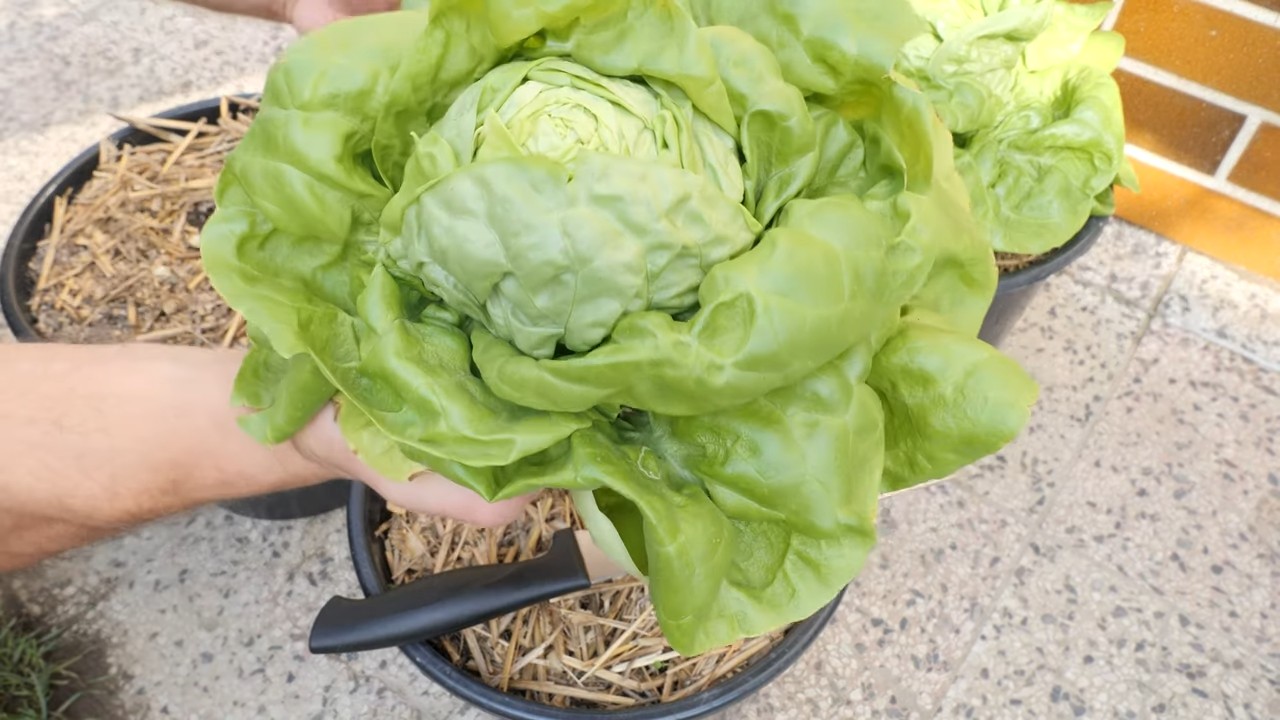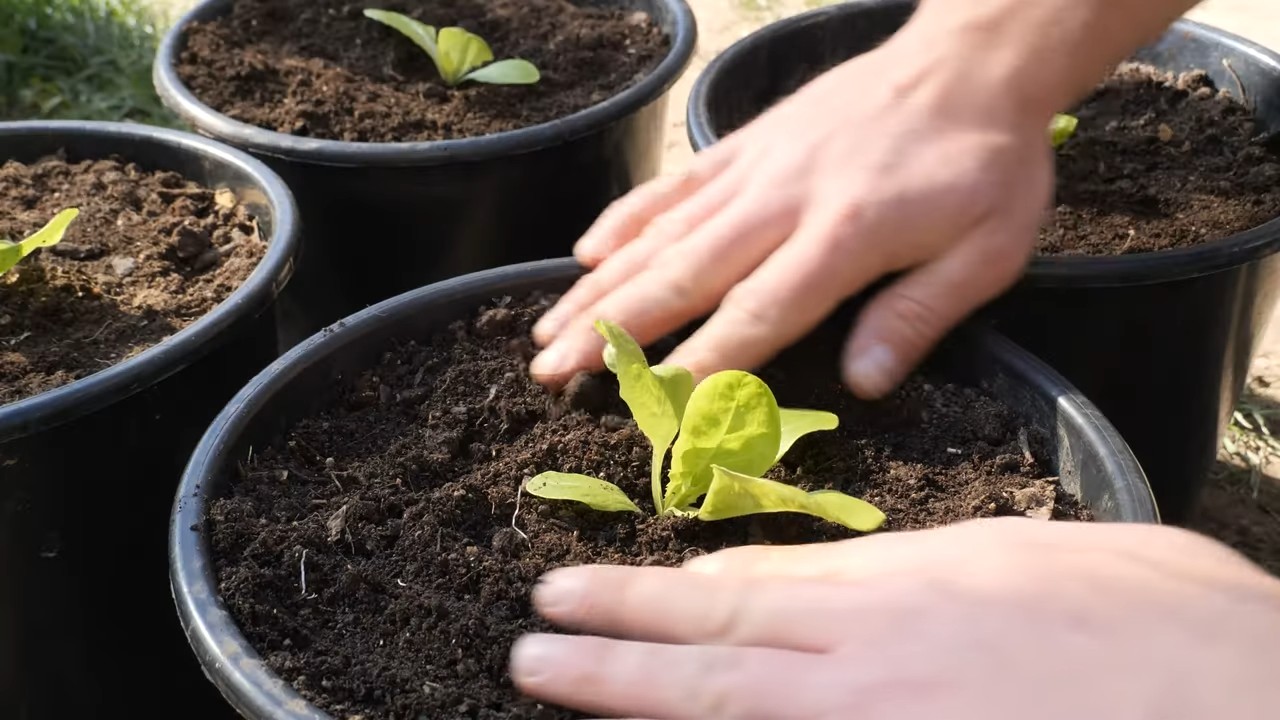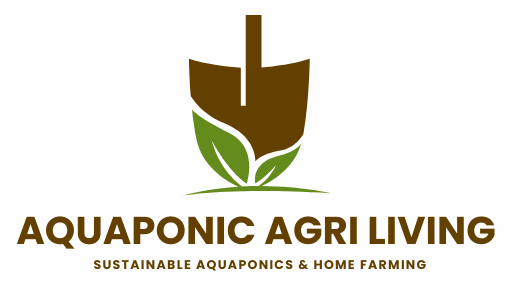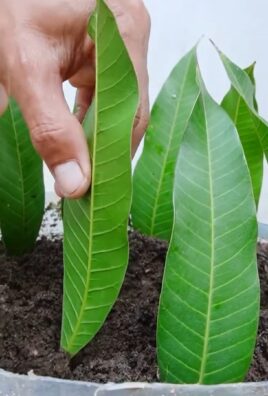Grow Lettuce in Pots: Imagine stepping outside your door and snipping fresh, crisp lettuce for your salad, sandwich, or even a quick snack. No more trips to the grocery store for wilted greens! This isn’t just a dream; it’s a reality you can easily achieve with a few simple steps. For centuries, container gardening has allowed people to cultivate their own food, even in limited spaces. From ancient rooftop gardens in Babylon to modern-day apartment balconies, the desire to connect with nature and grow our own food is deeply ingrained in us.
But let’s face it, not everyone has a sprawling backyard suitable for a traditional garden. That’s where the magic of growing lettuce in pots comes in! This DIY guide is your ticket to fresh, homegrown lettuce, regardless of your living situation. I’ll walk you through everything you need to know, from choosing the right pot and soil to watering and harvesting your delicious leafy greens.
Why is this DIY trick so essential? Because fresh, organic lettuce is not only tastier but also healthier. You control what goes into your plants, ensuring they’re free from harmful pesticides and chemicals. Plus, there’s something incredibly satisfying about nurturing a plant from seed to table. So, are you ready to embark on this rewarding journey? Let’s get started and grow lettuce in pots like a pro!

Grow Your Own Delicious Lettuce in Pots: A Beginner’s Guide
Hey there, fellow gardening enthusiasts! I’m so excited to share my experience with growing lettuce in pots. It’s surprisingly easy, even if you don’t have a huge backyard. Fresh, crisp lettuce right outside your door? Yes, please! This guide will walk you through everything you need to know, from choosing the right pot to harvesting your bounty. Let’s get started!
What You’ll Need
Before we dive in, let’s gather our supplies. Here’s a checklist to make sure you’re prepared:
* Pots: Choose pots that are at least 6 inches deep and wide. The bigger, the better, as it gives the lettuce roots more room to grow. I personally love using terracotta pots because they look great and allow the soil to breathe, but plastic pots work just fine too.
* Potting Mix: Don’t use garden soil! It’s too heavy and doesn’t drain well in pots. Opt for a high-quality potting mix specifically designed for containers. I usually go for a mix that contains peat moss, perlite, and vermiculite.
* Lettuce Seeds or Seedlings: You can start from seeds or buy seedlings from your local garden center. Seeds are more economical, but seedlings give you a head start. I’ve had success with both! Romaine, butterhead, and loose-leaf varieties are all great choices for containers.
* Watering Can or Hose: You’ll need a gentle way to water your lettuce without disturbing the soil.
* Fertilizer (Optional): A balanced liquid fertilizer can help your lettuce grow faster and produce more leaves. I like to use an organic fertilizer diluted to half strength.
* Trowel or Small Shovel: For planting seeds or seedlings.
* Gardening Gloves (Optional): To keep your hands clean.
Choosing the Right Lettuce Variety
Not all lettuce varieties are created equal, especially when it comes to container gardening. Here are a few of my favorites that thrive in pots:
* Romaine: This classic lettuce is known for its crisp leaves and upright growth habit. It’s perfect for salads and sandwiches.
* Butterhead (Boston or Bibb): Butterhead lettuce has soft, buttery leaves and a mild flavor. It’s a great choice for salads and wraps.
* Loose-Leaf (Red Sails, Black Seeded Simpson): Loose-leaf lettuce is the easiest to grow and harvest. You can pick individual leaves as needed, and the plant will continue to produce more.
* Mesclun Mix: This is a blend of different lettuce varieties and other greens, like arugula and spinach. It’s a great way to add variety to your salads.
Planting Your Lettuce
Now for the fun part! Let’s get those lettuce seeds or seedlings into their new home.
Starting from Seeds
1. Prepare the Pot: Fill your pot with potting mix, leaving about an inch of space at the top. Gently pat down the soil to create a firm surface.
2. Sow the Seeds: Sprinkle the lettuce seeds evenly over the surface of the soil. You don’t need to bury them too deep; just lightly cover them with a thin layer of potting mix.
3. Water Gently: Use a watering can or hose with a gentle spray nozzle to water the soil thoroughly. Be careful not to wash away the seeds.
4. Provide Light: Place the pot in a sunny location that receives at least 6 hours of sunlight per day. If you’re starting your seeds indoors, you may need to use a grow light.
5. Keep the Soil Moist: Water the soil regularly to keep it consistently moist, but not soggy. Check the soil moisture by sticking your finger into the soil. If it feels dry, it’s time to water.
6. Thin Seedlings (If Necessary): Once the seedlings emerge and have a few true leaves, you may need to thin them out to prevent overcrowding. Remove the weaker seedlings, leaving the strongest ones spaced about 2-4 inches apart.
Planting Seedlings
1. Prepare the Pot: Fill your pot with potting mix, leaving about an inch of space at the top.
2. Dig Holes: Dig small holes in the soil, spaced about 4-6 inches apart. The holes should be large enough to accommodate the root balls of the seedlings.
3. Remove Seedlings from Containers: Gently remove the seedlings from their containers, being careful not to damage the roots. If the roots are tightly bound, gently loosen them with your fingers.
4. Plant the Seedlings: Place the seedlings in the holes and gently backfill with potting mix. Make sure the top of the root ball is level with the soil surface.
5. Water Thoroughly: Water the seedlings thoroughly to help them settle into their new home.
6. Provide Light: Place the pot in a sunny location that receives at least 6 hours of sunlight per day.
Caring for Your Lettuce
Once your lettuce is planted, it’s important to provide it with the right care to ensure a healthy and bountiful harvest.
* Watering: Lettuce needs consistent moisture to thrive. Water your lettuce regularly, especially during hot, dry weather. Check the soil moisture daily and water when the top inch of soil feels dry. Avoid overwatering, as this can lead to root rot.
* Fertilizing: Lettuce is a relatively light feeder, but it can benefit from occasional fertilization. Use a balanced liquid fertilizer diluted to half strength every 2-3 weeks. Avoid over-fertilizing, as this can cause the lettuce to bolt (go to seed).
* Sunlight: Lettuce needs at least 6 hours of sunlight per day. If you live in a hot climate, provide some afternoon shade to prevent the leaves from wilting.
* Pest Control: Lettuce is susceptible to a few common pests, such as aphids, slugs, and snails. Inspect your plants regularly for signs of infestation. You can control aphids with a strong spray of water or by using insecticidal soap. Slugs and snails can be handpicked or trapped with beer traps.
* Weed Control: Keep your lettuce patch free of weeds, as they can compete for nutrients and water. Hand-pull weeds regularly or use a hoe to cultivate the soil.
* Bolting: Bolting is when lettuce plants send up a flower stalk and the leaves become bitter. This is usually caused by hot weather or stress. To prevent bolting, choose heat-tolerant varieties, provide afternoon shade, and water regularly. If your lettuce does bolt, you can still harvest the leaves, but they may not taste as good.
Harvesting Your Lettuce
The best part of growing your own lettuce is, of course, harvesting it! Here’s how to do it:
* When to Harvest: You can start harvesting lettuce leaves as soon as they are large enough to eat. For loose-leaf varieties, you can pick individual leaves as needed. For head lettuce varieties, wait until the head is firm and well-formed before harvesting.
* How to Harvest: To harvest loose-leaf lettuce, simply snip off the outer leaves with scissors or a knife. Leave the inner leaves to continue growing. To harvest head lettuce, cut the head off at the base of the plant with a sharp knife.
* Storage: Store harvested lettuce in the refrigerator in a plastic bag or container. It will stay fresh for several days.
Troubleshooting
Even with the best care, you may encounter some problems when growing lettuce. Here are a few common issues and how to address them:
* Yellowing Leaves: This can be caused by overwatering, underwatering, nutrient deficiency, or disease. Check the soil moisture and adjust your watering accordingly. Fertilize your lettuce with a balanced fertilizer. If you suspect disease, remove the affected leaves and treat the plant with a fungicide.
* Wilting Leaves: This can be caused by heat stress, underwatering, or root rot. Provide afternoon shade, water regularly, and make sure the soil is well-draining.
* Holes in Leaves: This is usually caused by slugs, snails, or other pests. Inspect your plants regularly for signs of infestation and take appropriate action.
* Bolting: As mentioned earlier, bolting is when lettuce plants send up a flower stalk and the leaves become bitter. To prevent bolting, choose heat-tolerant varieties, provide afternoon shade, and water regularly.
Enjoy Your Homegrown Lettuce!
Growing lettuce in pots is a rewarding experience that allows you to enjoy fresh, delicious greens right outside your door. With a little care and attention, you can have a continuous supply of lettuce throughout the growing season. So, grab your pots, seeds, and potting mix, and get ready to enjoy the taste of homegrown goodness! Happy gardening!

Conclusion
So, there you have it! Growing lettuce in pots is not only achievable, it’s downright rewarding. We’ve walked through the simple steps, highlighted the key considerations, and hopefully, inspired you to ditch the store-bought greens and embrace the freshness of homegrown lettuce.
Why is this DIY trick a must-try? Because it puts you in control. You control the soil, the sunlight, the watering schedule, and most importantly, the quality of your food. No more worrying about pesticides, long transportation times, or wilted leaves. You get crisp, delicious lettuce, harvested at its peak, right from your own patio, balcony, or even a sunny windowsill. Plus, it’s incredibly satisfying to nurture something from seed to salad.
But the beauty of growing lettuce in pots lies in its adaptability. Feel free to experiment! Try different varieties of lettuce – from the classic Romaine to the vibrant Red Sails or the buttery Butterhead. Mix and match them in a single pot for a colorful and flavorful salad blend. Consider adding companion plants like marigolds or basil to deter pests and enhance the overall health of your lettuce.
For a spicier kick, try growing arugula or mustard greens alongside your lettuce. If you’re short on space, vertical planters are an excellent option. You can even repurpose old containers like buckets, crates, or even old tires (just make sure they’re clean and have drainage holes).
Don’t be afraid to get creative with your potting mix. While a standard potting mix works well, you can enrich it with compost, worm castings, or other organic amendments to boost its nutrient content. Remember to monitor your lettuce plants regularly for signs of pests or diseases. Early detection is key to preventing problems from escalating.
Ultimately, the best way to learn is by doing. So, grab a pot, some seeds, and get your hands dirty! Experience the joy of watching your lettuce plants sprout, grow, and flourish. And most importantly, savor the taste of fresh, homegrown lettuce in your salads, sandwiches, and wraps.
We are confident that you will find success in your lettuce growing journey. We encourage you to embark on this rewarding endeavor.
Now, we want to hear from you! Have you tried growing lettuce in pots before? What are your favorite varieties? What tips and tricks have you learned along the way? Share your experiences, photos, and questions in the comments below. Let’s create a community of lettuce-loving gardeners and inspire each other to grow our own food. Let us know how you are growing lettuce in pots.
Frequently Asked Questions (FAQ)
What is the best type of lettuce to grow in pots?
The best type of lettuce to grow in pots depends on your personal preferences and growing conditions. However, loose-leaf varieties like Black Seeded Simpson, Salad Bowl, and Red Sails are generally well-suited for container gardening because they are relatively compact and can be harvested continuously. Butterhead varieties like Buttercrunch and Tom Thumb are also good choices. Romaine lettuce can be grown in pots, but it may require a larger container. Experiment with different varieties to see which ones thrive in your specific environment.
How big of a pot do I need to grow lettuce?
The size of the pot depends on the variety of lettuce you’re growing and how many plants you want to grow in a single container. For loose-leaf varieties, a pot that is at least 6 inches deep and 6 inches wide is generally sufficient for a single plant. For butterhead and romaine varieties, a pot that is at least 8 inches deep and 8 inches wide is recommended. If you want to grow multiple plants in a single pot, choose a larger container accordingly. A 12-inch pot can typically accommodate 3-4 lettuce plants.
What kind of soil should I use for growing lettuce in pots?
Lettuce prefers well-draining soil that is rich in organic matter. A good quality potting mix is generally the best option for growing lettuce in pots. Avoid using garden soil, as it can be too heavy and may not drain well. You can amend your potting mix with compost, worm castings, or other organic materials to improve its fertility and drainage.
How often should I water my lettuce plants?
Lettuce needs consistent moisture to thrive. Water your lettuce plants regularly, especially during hot, dry weather. The soil should be kept consistently moist, but not waterlogged. Check the soil moisture by sticking your finger into the soil. If the top inch of soil feels dry, it’s time to water. Avoid overwatering, as this can lead to root rot.
How much sunlight does lettuce need?
Lettuce needs at least 4-6 hours of sunlight per day. However, it can tolerate some shade, especially during the hottest part of the day. If you live in a hot climate, consider placing your lettuce plants in a location that receives morning sun and afternoon shade.
How do I harvest lettuce from pots?
You can harvest lettuce from pots by cutting off the outer leaves as needed. This is known as “cut-and-come-again” harvesting. Alternatively, you can harvest the entire head of lettuce at once. To do this, cut the lettuce at the base of the plant.
How do I prevent pests and diseases from affecting my lettuce plants?
To prevent pests and diseases from affecting your lettuce plants, start with healthy seedlings or seeds. Choose disease-resistant varieties whenever possible. Monitor your plants regularly for signs of pests or diseases. If you notice any problems, take action immediately. Common pests that affect lettuce include aphids, slugs, and snails. You can control these pests by handpicking them off the plants, using insecticidal soap, or setting up traps. Common diseases that affect lettuce include downy mildew and powdery mildew. You can prevent these diseases by providing good air circulation, avoiding overwatering, and using a fungicide if necessary.
Can I grow lettuce indoors?
Yes, you can grow lettuce indoors, but you’ll need to provide adequate light. A sunny windowsill that receives at least 4-6 hours of direct sunlight per day is ideal. If you don’t have enough natural light, you can use grow lights.
How long does it take for lettuce to grow in pots?
The time it takes for lettuce to grow in pots depends on the variety of lettuce and the growing conditions. Loose-leaf varieties typically mature in 30-45 days, while butterhead and romaine varieties may take 50-60 days.
Can I grow lettuce in the winter?
Yes, you can grow lettuce in the winter, but you’ll need to protect it from frost. You can do this by moving your pots indoors or covering them with a frost blanket. Choose cold-hardy varieties of lettuce for winter growing.




Leave a Comment